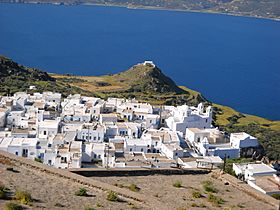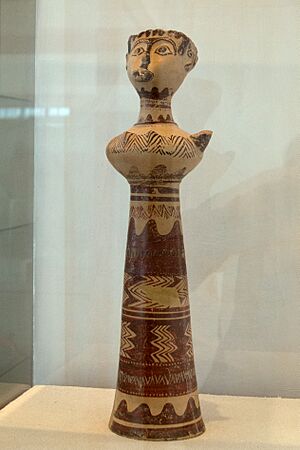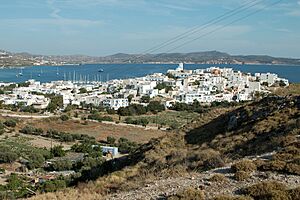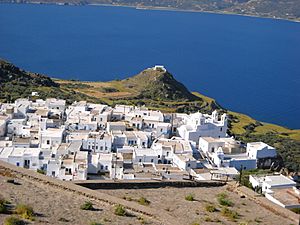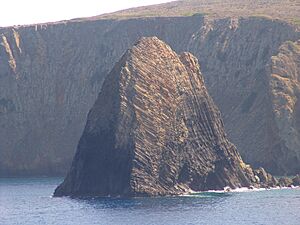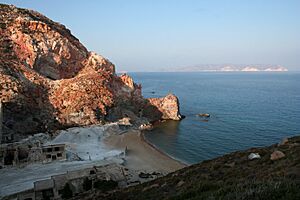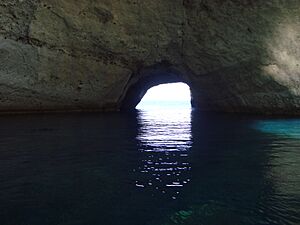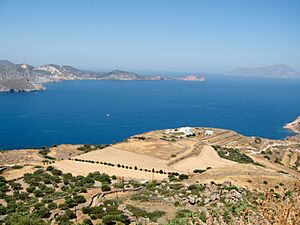Milos facts for kids
Quick facts for kids
Milos
Μήλος
|
||
|---|---|---|
|
||
| Country | Greece | |
| Administrative region | South Aegean | |
| Regional unit | Milos | |
| Area | ||
| • Municipality | 150.6 km2 (58.1 sq mi) | |
| Highest elevation | 751 m (2,464 ft) | |
| Lowest elevation | 0 m (0 ft) | |
| Population
(2021)
|
||
| • Municipality | 5,302 | |
| • Municipality density | 35.206/km2 (91.18/sq mi) | |
| Time zone | UTC+2 (EET) | |
| • Summer (DST) | UTC+3 (EEST) | |
| Postal code |
848 00, 848 01
|
|
| Area code(s) | 2287 | |
| Vehicle registration | EM | |
Milos (also called Melos) is a beautiful Greek island in the Aegean Sea. It's a volcanic island, meaning it was formed by volcanoes. Milos is the most southwestern island in a group called the Cyclades.
Many famous ancient statues were found here. These include the Venus de Milo (which is now in the Louvre Museum in Paris) and the Poseidon of Melos (now in Athens). Milos is a very popular place for tourists to visit, especially in the summer. The area of Milos also includes two small islands nearby, Antimilos and Akradies, which no one lives on. The total land area is about 160 square kilometers. In 2021, about 5,193 people lived on Milos.
Contents
Discovering Milos's Past
Milos has a very long history. People used a special volcanic rock called obsidian from Milos as far back as 15,000 years ago. Obsidian is like natural glass and was used to make very sharp tools. It was traded over long distances, even before farming began.
Milos was important because of its obsidian and its location between mainland Greece and Crete. But when people started using bronze to make weapons, obsidian became less important.
Life in the Bronze Age
The first big settlement on Milos was at a place called Phylakopi. This town grew as the use of obsidian started to decline. The first people living there were fishermen who caught tuna.
Archaeologists found old town walls and a special building at Phylakopi. They also found amazing wall paintings, like a famous one of a flying fish. These paintings looked similar to those found on the island of Crete. This suggests that artists from Crete might have worked on Milos.
Many ancient pots were found at Phylakopi, showing different styles over time. Later, during the Middle Bronze Age, the town grew much larger. Pottery from Crete became very common on Milos. This might mean Crete had a lot of influence over the Cycladic islands.
Archaeologists also found a large building called a megaron at Phylakopi. This type of building was usually found in the palaces of the Mycenaean civilization on mainland Greece. This could mean that the Mycenaeans took control of the settlement. A special shrine was also found, with many ancient statues, including the famous "Lady of Phylakopi." This shrine helps us understand the beliefs of the people who lived there. Eventually, the site was left empty and never lived in again.
The Dorian Settlers
The first Dorians (an ancient Greek group, like the Spartans) came to Milos around 1000 BC. They built a city on the eastern side of the bay, near where the village of Trypiti is today.
From the 6th century BC, Milos made its own coins. These coins often had a picture of an apple on them. This was a clever play on words, because the ancient Greek word for "apple" (mêlon) sounded like the island's name. The coins also showed the name of the people of Milos.
The Melians also learned to write using an old Greek alphabet. This writing style was used until 416 BC.
The Siege of Milos in 416 BC
During the Peloponnesian War (a big war between Athens and Sparta), the people of Milos tried to stay neutral. Even though they shared the same background as the Spartans, they didn't want to pick a side.
In 426 BC, the Athenians attacked the countryside of Milos. The next year, they demanded money from the island, but Milos refused. In 416 BC, Athens invaded again with a large army. They told Milos to join their side against Sparta, or they would destroy the island. The Melians said no.
So, the Athenian army surrounded the city. They eventually captured it in the winter. After the city fell, the Athenians took harsh actions against the people, leading to many losing their lives or being forced into slavery. Then, Athens sent 500 of their own people to live on the island.
However, in 405 BC, Athens started losing the war. A Spartan general named Lysander made the Athenian settlers leave Milos. He brought back the people who had survived the siege. Milos then became part of Sparta. After this, the unique culture of Milos slowly became more like the rest of Greece. They changed their coins and stopped making their special clay art.
Milos in Later Times
In 338 BC, Philip II of Macedon took control of Greece, including the Cyclades. During this time, Milos and the nearby island of Kimolos argued over who owned some smaller islands. Instead of fighting, they took their disagreement to a city called Ancient Argos on mainland Greece. The people of Argos decided the islands belonged to Kimolos.
Later, in 197 BC, the Romans became powerful in Greece, and Milos came under their influence.
In the early 9th century CE, Arab raiders attacked the Cyclades. It's not clear how Milos was affected, but it was still an important island to the Byzantine Empire in 1198.
Medieval and Ottoman Rule
After the Fourth Crusade in 1204, a Venetian named Marco I Sanudo took control of Milos and other Cycladic islands. He became the Duke of Naxos. His family ruled for many years, followed by another Catholic family called the Crispos. Most people on Milos were (and still are) Greek Orthodox Christians, while the rulers were Catholic.
In 1566, the Venetians gave the Duchy of Naxos to the Ottoman Empire. The Ottomans then officially took over the territory in 1579.
By the early 1700s, Milos had over 6,000 people, mostly Greek Christians. The island was ruled by a Turkish judge and a Turkish governor. However, the islanders managed their daily lives through three elected leaders. Even though they had some freedom, they didn't like the heavy taxes from the Ottomans.
In 1771, the Russian Empire occupied Milos for three years, but then the Ottomans took it back. By the late 1700s, the population of Milos dropped a lot, to under 500 people. Many buildings were left in ruins. But in the early 1800s, the population started to grow again.
Milos in Modern Times
Milos was one of the first islands to join the Greek War of Independence in 1821. The first naval battle of the war happened near Milos. Many people seeking safety from other islands, especially Crete, came to Milos. The port town of Adamantas was founded by refugees from Crete in 1841.
During the 1800s, Milos was an important meeting point for American and British ships fighting pirates in the Mediterranean Sea.
During World War II, the island faced difficult times under occupation. In 1943, 14 male civilians were sadly executed.
The population of Milos reached its highest point in 1928 with 6,562 people. In 2011, it was 4,977.
Exploring Milos's Geography
Milos is the most southwestern island in the Cyclades. It's about 120 kilometers east of mainland Greece. The island is about 23 kilometers long from east to west and 13 kilometers wide from north to south. Its area is about 151 square kilometers.
Most of Milos is rough and hilly, with the highest point being Mount Profitis Elias, which is 748 meters tall. Like other islands in the Cyclades, Milos was formed by volcanoes. Volcanic activity started millions of years ago. The last eruption was about 90,000 years ago, but it's still considered a dormant volcano that could erupt again.
The island has a natural harbor, which is actually a large volcanic crater. This harbor cuts into the island from the northwest, almost splitting it in two. In some caves on the south coast, you can still feel the heat from the volcano. There are also hot sulfur springs on the eastern side of the harbor.
Near Milos are other islands. Antimelos is an uninhabited island to the northwest. Kimolos, to the northeast, was known in ancient times for its figs. Polyaigos, southeast of Kimolos, is also uninhabited.
The main port town is Adamantas. From there, you can go up to a plateau where the main town, Plaka, is located. Above Plaka is Kastro, which sits on a hill. The ancient town of Milos was closer to the harbor entrance. Here, you can find a Roman theater and parts of old town walls. Many famous artworks, like the Venus de Milo, were found here. Other villages on Milos include Triovasalos, Peran Triovasalos, Pollonia, and Zefyria.
Milos's Climate
Milos has a Mediterranean climate. This means it has mild, rainy winters and warm to hot, dry summers.
| Climate data for Milos | |||||||||||||
|---|---|---|---|---|---|---|---|---|---|---|---|---|---|
| Month | Jan | Feb | Mar | Apr | May | Jun | Jul | Aug | Sep | Oct | Nov | Dec | Year |
| Record high °C (°F) | 21.6 (70.9) |
26.2 (79.2) |
25.6 (78.1) |
28.4 (83.1) |
35.4 (95.7) |
44.0 (111.2) |
41.0 (105.8) |
39.8 (103.6) |
36.3 (97.3) |
32.0 (89.6) |
27.8 (82.0) |
23.4 (74.1) |
44.0 (111.2) |
| Mean daily maximum °C (°F) | 12.9 (55.2) |
13.2 (55.8) |
14.8 (58.6) |
18.4 (65.1) |
22.8 (73.0) |
27.1 (80.8) |
28.1 (82.6) |
27.6 (81.7) |
25.2 (77.4) |
21.3 (70.3) |
18.0 (64.4) |
14.6 (58.3) |
20.3 (68.5) |
| Daily mean °C (°F) | 10.5 (50.9) |
10.7 (51.3) |
12.1 (53.8) |
15.2 (59.4) |
19.3 (66.7) |
23.5 (74.3) |
25.0 (77.0) |
24.6 (76.3) |
22.3 (72.1) |
18.5 (65.3) |
15.3 (59.5) |
12.3 (54.1) |
17.4 (63.3) |
| Mean daily minimum °C (°F) | 8.5 (47.3) |
8.5 (47.3) |
9.6 (49.3) |
12.4 (54.3) |
15.9 (60.6) |
19.8 (67.6) |
21.8 (71.2) |
21.6 (70.9) |
19.6 (67.3) |
16.1 (61.0) |
13.1 (55.6) |
10.3 (50.5) |
14.8 (58.6) |
| Record low °C (°F) | −2.0 (28.4) |
−2.0 (28.4) |
0.0 (32.0) |
5.4 (41.7) |
8.0 (46.4) |
10.0 (50.0) |
14.0 (57.2) |
14.2 (57.6) |
11.6 (52.9) |
8.0 (46.4) |
2.8 (37.0) |
0.0 (32.0) |
−2.0 (28.4) |
| Average precipitation mm (inches) | 74.7 (2.94) |
50.6 (1.99) |
47.2 (1.86) |
20.5 (0.81) |
13.1 (0.52) |
3.3 (0.13) |
0.3 (0.01) |
1.4 (0.06) |
5.8 (0.23) |
42.9 (1.69) |
60.7 (2.39) |
90.3 (3.56) |
410.8 (16.17) |
| Average precipitation days (≥ 1.0 mm) | 8.8 | 7.3 | 5.7 | 2.9 | 1.4 | 0.3 | 0.1 | 0.1 | 0.9 | 3.9 | 5.8 | 9.0 | 46.2 |
| Average relative humidity (%) | 73.3 | 72.5 | 72.0 | 67.0 | 63.5 | 58.8 | 60.1 | 63.4 | 66.8 | 71.3 | 73.9 | 73.7 | 68.0 |
| Source: NOAA | |||||||||||||
Milos's Natural Resources
Volcanic Minerals and Mining
Milos is rich in volcanic minerals. Bentonite, perlite, and pozzolana are dug up from the ground using open-pit mining. These minerals are then sold all over the world. In the past, people also mined baryte, sulfur, and gypsum on the island. Ancient writers even said Milos was the best place for sulfur. The special "Melian earth" was used as a color by ancient artists. As mentioned before, Milos was a key source of obsidian during the Stone Age.
Agricultural Crops and Plants
The island has many orange, olive, and cypress trees. However, Milos is quite dry, so there isn't a huge amount of plant life everywhere. The main crops grown here are vines (for grapes), cotton, and barley.
Medicinal Plants of Milos
Most of the western part of Milos is a protected natural area called a Natura 2000 site. This area is home to over 800 different types of plants. About 35 of these plants are found only in Greece.
Studies have shown that many native plants on Milos were used for medicine. People used them to treat different health problems. They also used them as insect repellents or disinfectants. The most common plant used was Greek sage. People on Milos have been using medicinal plants for a very long time, with records going back to the 16th century.
Sister Island Connection
 Shōdoshima, Kagawa, Japan (1989)
Shōdoshima, Kagawa, Japan (1989)

Milos has a special connection with Shōdoshima, an island in Japan. They are "sister islands." The windmill in Shōdoshima Olive Park was a gift from Milos.
Milos's Population Over Time
Here's how the number of people living on Milos has changed over the years:
| Year | Island population |
|---|---|
| 1798 | 500 |
| 1812 | 2,300 |
| 1821 | 5,000 |
| 1907 | 5,393 |
| 1928 | 6,562 |
| 1991 | 4,380 |
| 2001 | 4,771 |
| 2011 | 4,978 |
Milos Today: A Popular Destination
Milos is not as famous as some other Greek islands like Santorini or Mykonos. However, it has become much more popular for vacations in recent years. People love its traditional Greek buildings, its slower and more relaxed pace, and its many different kinds of beaches.
Famous People from Milos
- Antonio Millo (active 1557–1590), a captain and mapmaker.
- Antonio Vassilacchi (1556–1629), a painter.
- Diagoras (5th century BC), a philosopher.
- Melanippides (5th century BC), a poet.
See also
 In Spanish: Milo para niños
In Spanish: Milo para niños


